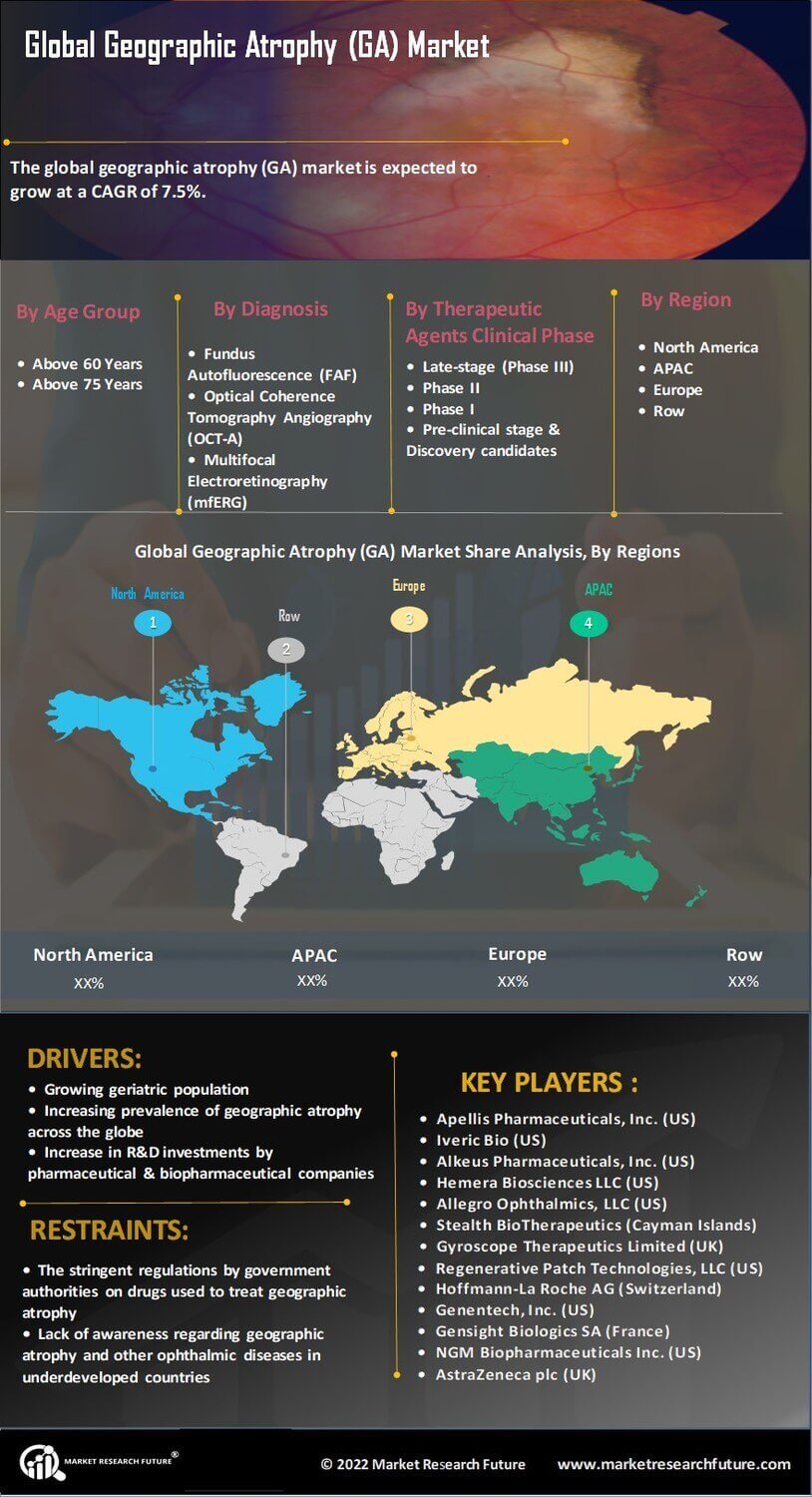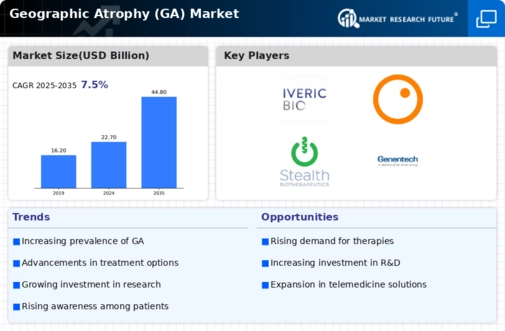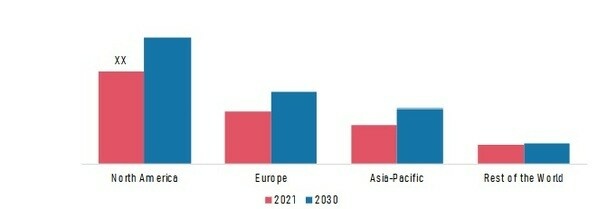Growing geriatric population to boost the market growth
Geographic atrophy is one of the most common eye disorders in people over 60. It is the final stage of dry age-related macular degeneration (AMD), and it might lead to irreparable retinal loss. In geographic atrophy, a sharply delineated oval or round area of hypopigmentation occurred, and it has a diameter of at least 175 µm. According to a United Nations (UN) report released in December 2020, there were 727 million individuals aged 65 or over in 2020, and it is predicted that this number would increase to 1.5 billion by the year 2050.
The rising life expectancy and falling fertility rates are both contributing to the world's rapidly expanding senior population. Additionally, according to the World Bank, the geriatric population (those over 65) made up 9.3% of the population in 2020, up from 5.9% in 1985.
Furthermore, in developed nations such as the US, the UK, France, Germany, and others have, approximately 1 in 29 people over the age of 75 suffering from geographic atrophy. Thus, older people are at a higher risk of having geographic atrophy. Hence, the increasing geriatric population across the globe is positively impacting the geographic atrophy (GA) market.
The graph that follows illustrates the treatment variations between the pegcetacoplan monthly, every other month, and sham treatment arms overall, as well as according to the tertiles of gender and age. Greater progression (i.e., greater mean change from baseline) is represented by data points on the right-hand side. Moreover, the primary analysis (mixed-effect model) of the sham group in the Phase 2 study shows the geographic atrophy progression as a vertical line. The upper and lower confidence limits of the mean are represented by colored bars.
Geographic Atrophy (GA) Market Segment Insights
Geographic Atrophy (GA) Age Group Insights
The geographic atrophy (GA) market segmentation, based on age group, includes those above 60 years and above 75 years. The above 75 years segment held the majority share in 2021 in the geographic atrophy (GA) market revenue. This is primarily owing to the rising prevalence of geographic atrophy in the above 75 years age group is due to age-related. For instance, according to the Retina Study Group of Portugal, geographic atrophy affects 1.3% of adults between the ages of 75 and 84, rising to approximately 22% by the age of 90.
November 2021 Iveric Bio's(US) avacincaptad pegol (ACP, also known as Zimura), a novel investigational complement C5 inhibitor for the treatment of geographic atrophy (GA) secondary to age-related macular degeneration (AMD), has received Breakthrough Therapy designation from the U.S. Food and Drug Administration (FDA).
Geographic Atrophy (GA) Diagnosis Insights
The geographic atrophy (GA) market segmentation is based on diagnosis includes fundus autofluorescence (FAF), optical coherence tomography angiography (OCT-A), and multifocal electroretinography (MfERG). The optical coherence tomography angiography (OCT-A) segment dominated the market in 2021 and is projected to be the faster-growing segment during the forecast period, 2022-2030. This is due to optical coherence tomography angiography (OCT-A) has evolved as a non-invasive technology for visualizing the retina's and choroid's microvasculature. It is useful for the diagnosis and understanding of many retinal conditions such as geographic atrophy, diabetic retinopathy, dry age-related macular degeneration, wet age-related macular degeneration, vascular occlusions, and others.
For instance, the AngioVue OCTA system is based on optical coherence tomography angiography offered by Optovue, Inc. (US).
Geographic Atrophy (GA) Therapeutic Agents Clinical Phase Insights
The geographic atrophy (GA) market data has been bifurcated into late-stage (Phase III), Phase II, Phase I, and pre-clinical stage & discovery candidates. The late-stage (Phase III) segment dominated the market in 2021 and is projected to be the faster-growing segment during the forecast period, 2022-2030. The growth of the biopharmaceutical companies’ segment in the market is mainly due to the Phase III clinical trials used to see if a new medicine or drug combination is better or equal to the current standard of care.
For instance, Galderma Laboratories LP (US), an anti-inflammatory Doxycycline, is being studied in phase III clinical trials for the treatment of geographic atrophy. Hence, rising late-stage (Phase III) clinical trials in the geographic atrophy industry are likely to be the key factor driving the growth of this segment in the market.
September 2021 Apellis Pharmaceuticals, Inc. (US) highlighted the best results from the phase III clinical trial for APL-2 Therapy in geographic atrophy and planned to file a new drug application with the FDA in the first half of 2022.
Geographic Atrophy (GA) Regional Insights
By Region, the study segments the market into North America, Europe, Asia-Pacific, and the Rest of the World. The North America geographic atrophy (GA) market is expected to account for USD XX billion in 2021 and is expected to exhibit an XX% CAGR during the study period. This is attributed to the rising investment in the healthcare industry and the presence of major key players in the region such as Apellis Pharmaceuticals, Inc. (US), Iveric Bio (US), Alkeus Pharmaceuticals Inc. (US), and others.
Moreover, the rising number of patients suffering from geographic atrophy and growing government initiatives related to geographic atrophy in the region further fuel the growth of the market.
Further, the major countries studied are the U.S., Canada, Germany, France, the UK, Italy, Spain, China, Japan, India, Australia, South Korea, and Brazil.
Europe geographic atrophy (GA) market is expected to account for the second-largest market share due to the rising older population, increasing demand for technologically innovative treatment, and growing R&D investment by the biopharmaceutical industry. Further, the Germany geographic atrophy (GA) market is expected to hold third place for the market share, and the UK geographic atrophy (GA) market is expected to fastest-growing market, and which is in the 4th place in the European region. Furthermore, France geographic atrophy (GA) market will hold the 5th place for the market share.
The Asia-Pacific geographic atrophy (GA) market is expected to grow at a CAGR of XX% from 2022 to 2030. This is due to the developing healthcare infrastructure, the establishment of research organizations, and the rising prevalence of AMD disorders among the elderly population. Moreover, China geographic atrophy (GA) market is expected to hold the largest market share, and the India geographic atrophy (GA) market is expected fastest-growing market in the Asia-Pacific region.
For instance, According to World Health Organization (WHO), 90% of the total visually impaired people live in developing countries such as China, India, and others, to become the leader in the geographic atrophy (GA) market.
The Rest of the World includes the Middle East, Africa, and Latin America. Government initiatives to increase medical expenditure and increase healthcare infrastructure in the region contribute to the growth of the geographic atrophy (GA) market.
The increasing prevalence of geographic atrophy among the aging population underscores the urgent need for innovative therapeutic strategies and enhanced healthcare access to address this debilitating condition.
National Eye Institute, National Institutes of Health






